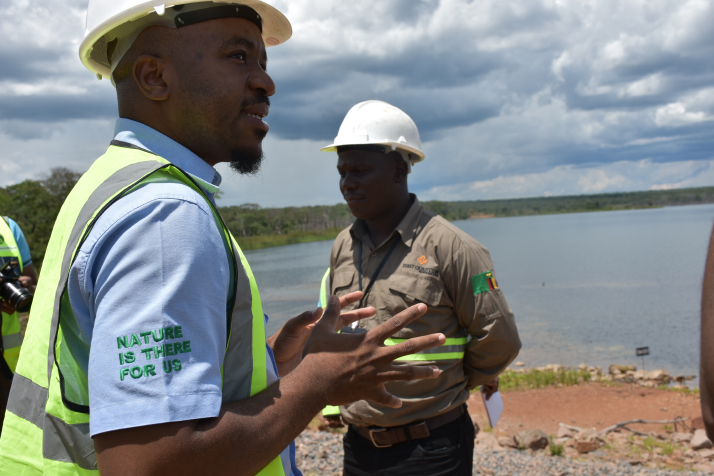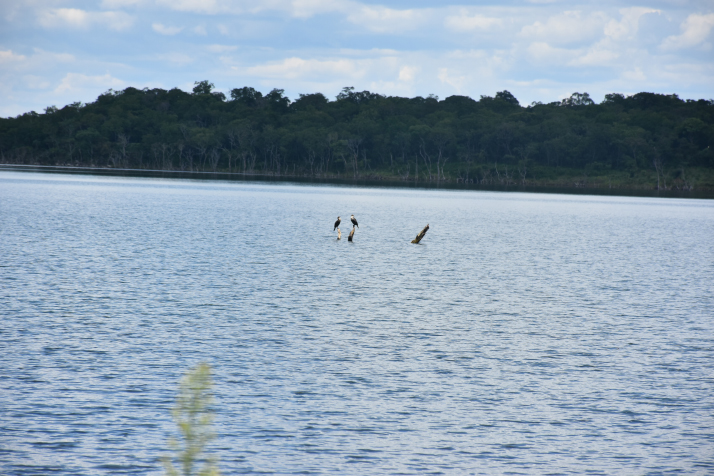|
||||||||||
| Home Nation World Business Opinion Lifestyle ChinAfrica Multimedia Columnists Documents Special Reports |
|
||||||||||
| Home Nation World Business Opinion Lifestyle ChinAfrica Multimedia Columnists Documents Special Reports |
| ChinAfrica |
| Zambia takes measures to protect water resources and ensure ecological progress |
| Keeping rivers flowing freely and safeguarding its ecological system is vitally important for the future of people and nature. Hence, Zambia has over the years put in place policies, strategies and programs that promote conservation of the fauna and flora in the country |
| By Derrick Silimina VOL.13 MARCH 2021 ·2021-02-26 |

Africa is a haven of excellent natural conditions and is rich in freshwater bodies with great potential to revamp its socio-economic development.
In Zambia, water resources form the basis of almost every aspect of life and include major rivers such as the mighty Zambezi River, Chambeshi River, Kafue River and Luangwa River. Others include Lake Kariba and the Itezhi-tezhi lake which all provide sustenance to animals, human life and biodiversity.
Supporting livelihood
Apart from sustaining biodiversity, water resources in the southern African country are critical for meeting the basic needs of industrial development, sanitation and waste management, factors that drive the social, economic, political and cultural development of the population along the rivers.
For instance, fishing is a big business in Zambia and is one of the sources of income for most of the people that live along major rivers such as the Zambezi.
"This business is our only source of livelihood here and without it, most of us wouldn't be able to provide for our families," said Memory Simushi, 32, who has been a fishmonger in Mongu district in western Zambia since 2018.
Each day around 3 a.m. when many people are deep in slumber, Simushi and other women of Nalolo area in Mongu district trek along the Barotse flood plains to buy the best fish from fishermen in the lower Zambezi fishing camp.
The two-hour journey on foot to reach the camp is quite challenging as the women have to walk in darkness. The fish they hope to buy is known as litapi in Lozi. The women will resell what they got in the fishing camp in Mongu town, a source of income to support their families. The fish sell like hot cake in the local market at K400 ($20) per basin, from which they make a profit of K100 to K150.
According to the Ministry of Fisheries and Livestock, the fishing industry contributes 3.2 percent to Zambia's GDP and provides more than 70,000 metric tons of fish per annum.
On the other hand, the upper Barotse flood plains, renowned for their annual floods, still bring pride in anticipation of an abundant harvest.

Protecting waters
Keeping rivers flowing freely and safeguarding its ecological system is vitally important for the future of people and nature. Hence, Zambia has over the years put in place policies, strategies and programs that promote conservation of the fauna and flora in the country.
For instance, the National Conservation Strategy was formulated in 1985 which provided a solid base for a coordinated approach to the country's environmental management culminating into the promulgation of the Environmental Protection and Pollution Control Act No. 12 of 1990. This piece of legislation established the Environmental Council of Zambia, now the Zambia Environmental Management Agency (ZEMA) as a statutory body charged with the mandate to regulate water, environmental management and pollution control, among others.
In 1999, the first National Biodiversity Strategy and Action Plan (NBSAP) was formulated to respond to new challenges and align it to global frameworks, including the Strategic Plan on Biodiversity from 2011 to 2020 and its Aichi Targets, according to the Ministry of Lands, Natural Resources and Environmental Protection.
The second NBSAP represents Zambia's quest to domesticate broader international frameworks including the Sustainable Development Goals and other national obligations under the international instruments which the country is party to, including the Convention on Biological Diversity, the UN Framework Convention on Climate Change, as well as regional SADC protocols on wildlife, water, fisheries, forestry, and biosafety among others.
However, recent investigations by ZEMA in Copperbelt Province have revealed that some of the most affected water bodies having high levels of pollution are all tributaries of the Kafue River, which in turn flows into the Zambezi River while the major pollutants of the water bodies were copper, cobalt, and iron among others.
"These pollutants have adversely affected the said water bodies resulting in among other effects, siltation of stream beds, changes to the water chemistry, and impact on aquatic life and adversely affecting other water users including domestic users," Lloyd Kaziya, former minister of Water Development, Sanitation and Environment said in a ministerial statement on pollution of water sources as a result of mining activities in north-western Zambia.
It is for this reason that, ZEMA has instituted investigations and increased the frequency of monitoring of industries to ensure control and compliance to national standards for emissions not only into water but air as well, in a bid to revive aquatic life and its surroundings.
Consequently, there is a global concern to safeguard and restore the ecological environment of rivers as transboundary water bodies cross national and administrative borders across the globe, thereby supporting majority of the world's population and ecosystems.
In the Southern African region, eight countries, namely Angola, Namibia, Botswana, Zimbabwe, Zambia, Tanzania, Malawi, and Mozambique, share the Zambezi River basin, the fourth largest in Africa. Approximately 30 million people live in the basin, which has its headwaters in Zambia. The main river channel forms the borders between Zambia and Zimbabwe, and Zambia and Botswana before reaching the ocean in Mozambique.
Locally, in its continued effort to conserve biodiversity while improving the welfare of local people, the Wildlife and Environmental Conservation Society of Zambia has embarked on a Conservation and Forest Management project in the Mafinga Hills of northern Zambia, and the project has trained about 60 people from three villages where the inhabitants are mostly traditional pastoralists who act as guardians of biological diversity. They also play a critical role in the preservation of the headwaters of the Luangwa River.
Conservation cooperation
China and Zambia seek to explore innovative ways to promote conservation of biodiversity amid growing threats linked to human behaviour and climate change.
Recently, Chinese Ambassador to Zambia Li Jie shared his thoughts with Zambia's Minister of Fisheries and Livestock Kampamba Mulenga, and called on the two sister nations to adhere to the principle of mutual respect and win-win cooperation.
The Chinese envoy affirmed that Zambia is blessed with excellent natural conditions and is rich in freshwater and forage resources with great potential for the development of fish farming and livestock husbandry.
"China is willing to work together with Zambia to fully implement the outcomes of the FOCAC Beijing Summit and promote practical cooperation in all fields," Li said.
And Mulenga expressed her sincere appreciation to the Chinese side for the long-term support and assistance to Zambia's economic and social development and people's livelihood, adding that she expects more Chinese companies to come to invest in Zambia and bring advanced technology. CA
(Print Edition Title: Preserving a Source of Life)
Reporting from Zambia
Comments to zanjifang@chinafrica.cn
| About Us | Contact Us | Advertise with Us | Subscribe |
| Copyright Beijing Review All rights reserved 京ICP备08005356号-5 京公网安备110102005860号 |